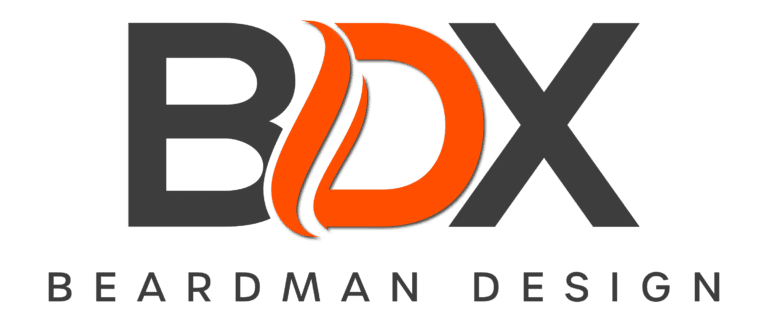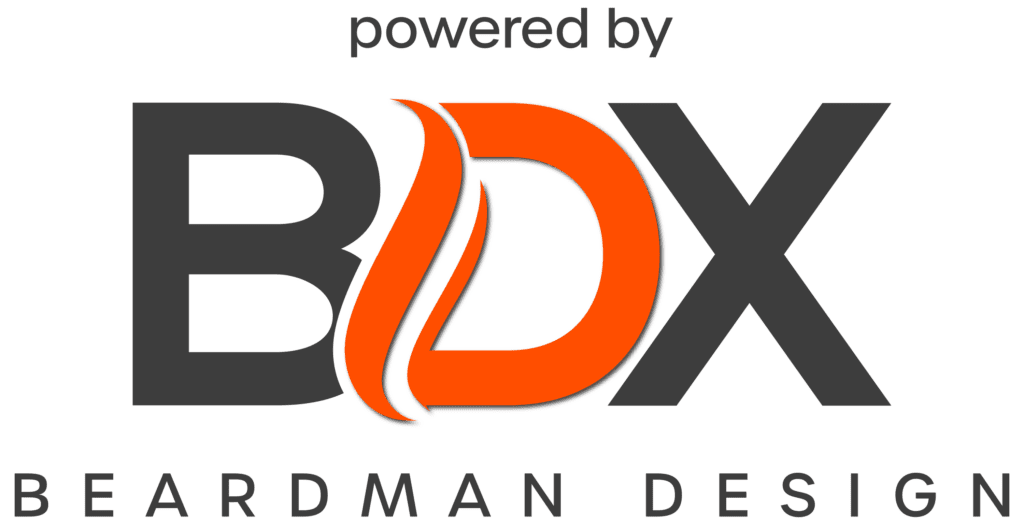In today’s digital age, many of us turn to search engines for answers, insights, methodologies, or services. With Google registering a staggering 3.5 billion queries daily, it’s evident that search engines have woven themselves into the fabric of our daily routines. Consequently, they’ve also become a cornerstone of modern business marketing.

Remarkably, 49% of marketers view organic search — the standard, non-advertising search results — as the most lucrative ROI channel. This organic search realm is navigated and harnessed by businesses through the art and science of search engine optimization, commonly known as SEO.
So, how can leveraging search engines elevate your business? Dive into this comprehensive SEO guide, and begin to understand the nuances of achieving higher Google rankings, driving increased website traffic, and enhancing your brand’s credibility.
What is the meaning of SEO?
SEO is an acronym for “search engine optimization.” To understand this in relation to your website, let’s dissect it further:
Search: The action individuals take when searching for answers, solutions, or specific products and services that cater to their requirements.
Search Engine: Platforms such as Google or Bing where these searches are executed.
Search Engine Optimization: The techniques and strategies employed to ensure that these search engines align a user’s query with your website.
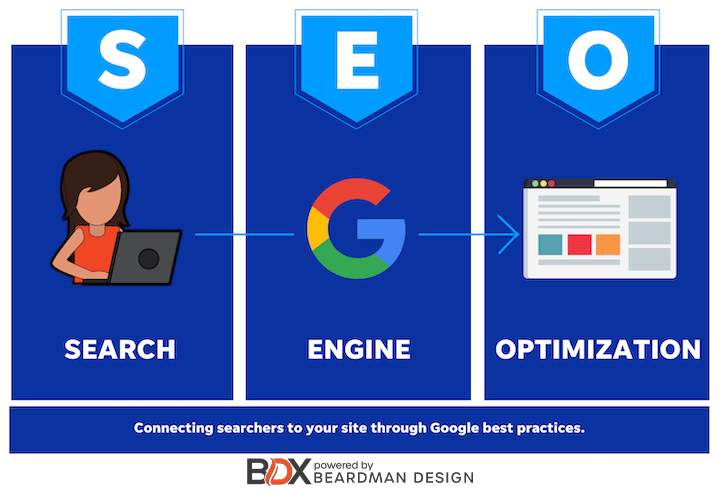
What Exactly is SEO?
While it’s clear that RPA stands for robotic process automation, simply knowing the abbreviation doesn’t provide a full understanding of its essence. Similarly, what does search engine optimization truly entail?
A Detailed Explanation of SEO:
Search engine optimization encompasses a combination of technical and content-driven methodologies designed to align a webpage with a search engine’s ranking criteria. This ensures the page is easily accessible, indexed, and prominently displayed in the Search Engine Results Page (SERP) for pertinent searches.
A More Streamlined Definition of SEO:
SEO involves refining your website’s architecture and content to ensure it becomes a beacon for those seeking the solutions or information you provide, all through the lens of search engines.
The Most Direct Definition of SEO:
At its core, SEO is the strategy you employ to achieve a superior ranking on Google, thereby driving more visitors to your website.
It’s worth noting that while Google is a dominant player in the search engine realm, it’s not the only one. Bing, various directory-based search engines, and even platforms like Instagram serve as search engines. However, with Google holding a commanding 92% market share, for most intents and purposes, the terms “Google” and “search engine” are often used interchangeably.
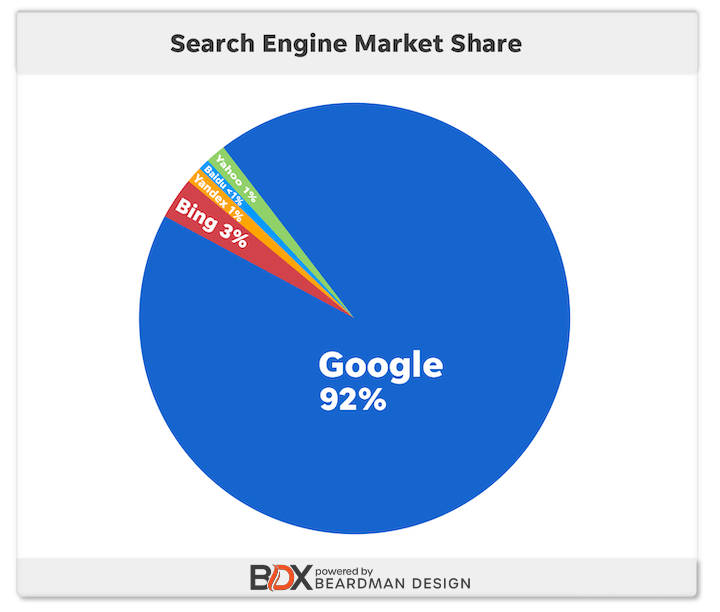
The Advantages & Significance of SEO
Every day, individuals are on the hunt, searching for topics that range from the general to those closely tied to your business. Each of these searches represents a chance for you to engage with potential customers, address their queries, offer solutions, and position yourself as a reliable authority in their eyes.
Boosted Web Traffic: A website fine-tuned for search engines naturally attracts a larger audience, leading to heightened brand recognition.
Increased Clientele: Effective optimization means targeting specific keywords that resonate with your ideal audience, ensuring the traffic you attract is relevant and likely to convert.
Enhanced Credibility: Securing a top spot on Google’s rankings not only boosts your visibility but also lends significant trustworthiness to your brand. If you’re endorsed by Google, the public is more inclined to trust you.
Amplified Returns: Every dollar you invest in your website and associated marketing endeavors yields better results when your site is optimized, ensuring you get the best bang for your buck.
In essence, if your goals encompass greater brand recognition, online prominence, lead generation, sales, or fostering a loyal customer base, SEO is the key to unlocking that potential.
🔍 Is your site optimized for search? 🔎
Get a free SEO audit with the LOCALiQ website grader.
Varieties of SEO
Search engines, including Google, evaluate a myriad of elements when determining the rank of content. Consequently, SEO is multifaceted and can be categorized into three primary segments: on-page, off-page, and technical SEO:
On-page SEO: This involves enhancing the content’s quality and layout on a webpage. Factors like content caliber, keyword usage, and HTML tagging are pivotal in on-page SEO.
Off-page SEO: This revolves around acquiring links from other websites, as well as interlinking pages within your own site. Elements like backlinks, internal connections, and brand credibility play a significant role here.
Technical SEO: Focuses on elevating your website’s overall performance in search engine evaluations. Aspects such as website security (like SSL certificates), user experience (UX), and site architecture are paramount.
Beyond these primary categories, SEO can be further divided into three specialized subcategories:
Local SEO: Aims to position your business prominently in Google Maps and in local search results. Key factors here include customer reviews, local listings, and optimizing your Google Business profile.
Image SEO: Combines on-page and technical tactics to ensure images on your web pages rank well in Google’s image search.
Video SEO: Integrates on-page, technical, and off-page methodologies to optimize your videos for higher rankings on platforms like YouTube or in Google’s video search results.
It’s worth noting that while all three subcategories utilize the main SEO types, the emphasis on each varies based on the specific subtype.
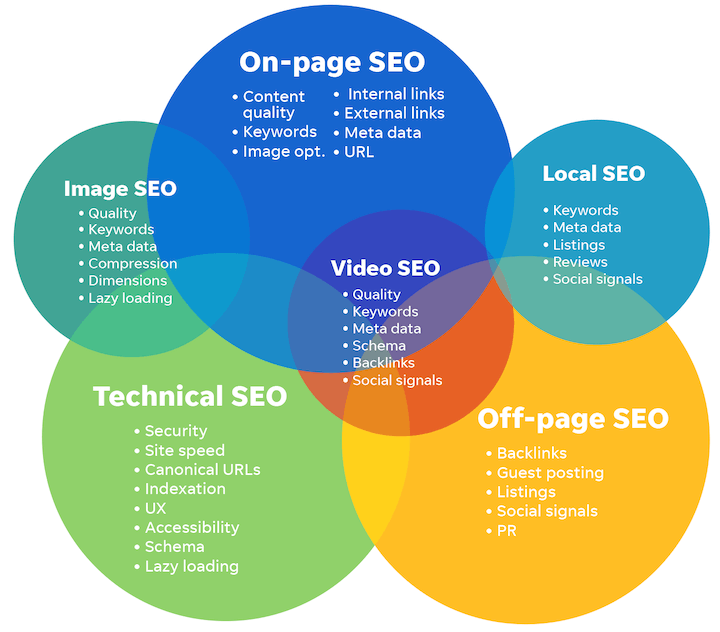
Understanding the Mechanics of SEO
Ever wondered how Google decides which web pages to display on its search engine results page (SERP) for a particular search term? How does this process lead to increased traffic to your site? Let’s delve into the inner workings of SEO.
- Google deploys search spiders that tirelessly roam the internet, collecting, sorting, and archiving the countless web pages in its vast database. When you initiate a search, Google retrieves results from this database, not directly from the internet.
- To rank these results, Google employs a sophisticated formula, known as an algorithm. This algorithm arranges the results based on various criteria (ranking factors, which we’ll explore shortly). These criteria encompass content quality, its pertinence to the search term, the credibility of the website (domain) it’s hosted on, among others.
- The way users engage with these search results provides Google with insights into the effectiveness of each page in meeting user needs. This user behavior is also integrated into the algorithm’s considerations.
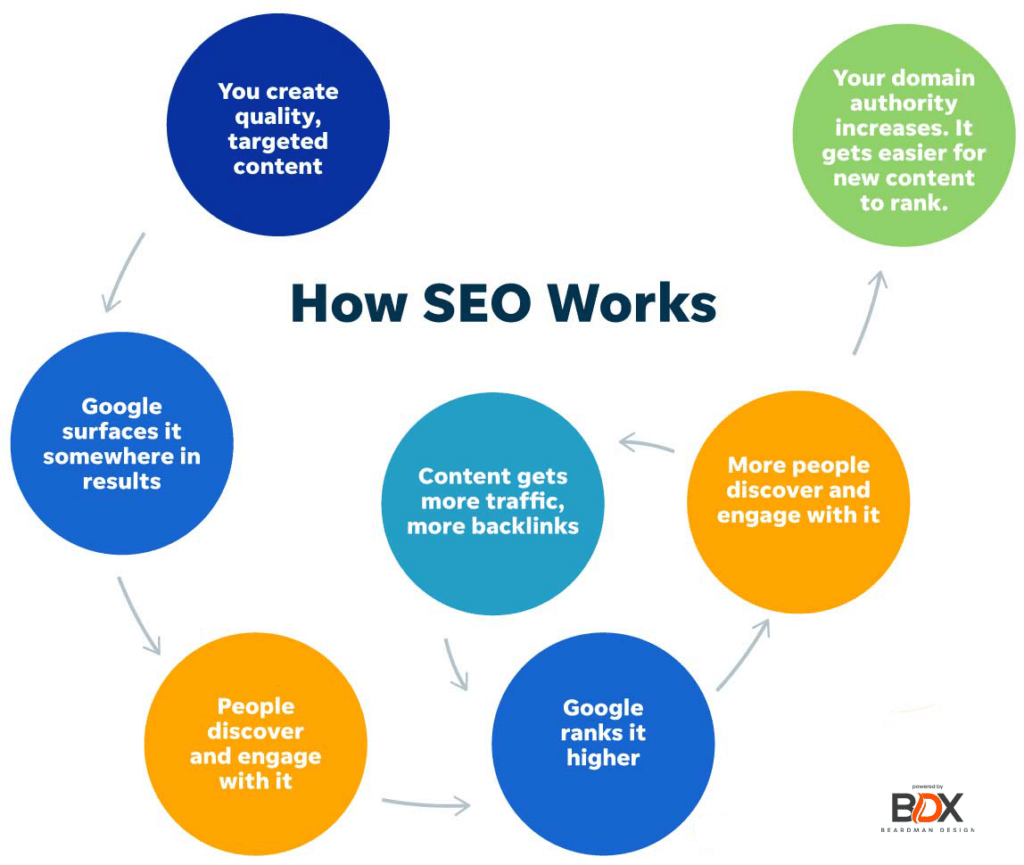
To put it simply, SEO operates as an intricate feedback loop, aiming to present the most precise, credible, and pertinent results for any search query. This is achieved through a collaborative effort involving you, Google, and the users. Your responsibility is to craft content that aligns with Google’s criteria for expertise, authority, and trust (E-A-T), ensuring it meets the needs of its users.
Google SEO Ranking Elements
What does Google look for when determining the rank of content? What defines content that is of high quality, targeted, aligns with E-A-T guidelines, and is optimized for SEO? While Google employs hundreds of ranking elements and frequently updates its algorithm to enhance user experience, there are 12 factors that demand special attention.
As highlighted by FirstPageSage, here’s a breakdown of the most influential Google ranking criteria and their respective importance:
- Regularly producing top-tier content (26%)
- Presence of keywords in the meta title (17%)
- Quality backlinks (15%)
- Expertise within a specific niche (13%)
- Level of user engagement (11%)
- Effective internal linking (5%)
- Mobile optimization and prioritization (5%)
- Loading speed of the page (2%)
- Website security through SSL certification (2%)
- Implementation of schema markup or structured data (1%)
- Keywords incorporated in the URL (1%)
- Keywords featured in the H1 tag (1%)
However, it’s essential not to underestimate the factors that appear less significant on this list. As illustrated in the subsequent chart, the “Other” category, which includes aspects like unlinked mentions, social indicators, domain’s past, external links, and the overall website layout, holds a 1% significance. Considering there are around 200 known Google ranking elements, this means there are approximately 189 “other” elements contributing to this 1%. This implies that factors, such as keywords in the URL, which individually contribute 1%, have a more substantial impact than they might initially seem.
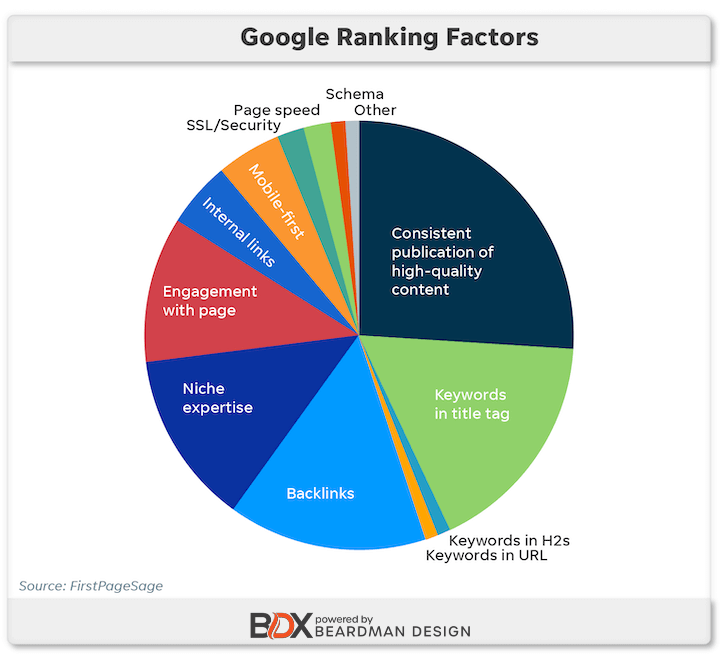
SEO Essentials: On-Page Optimization Techniques
Diving into the practical side of SEO, let’s explore how to effectively optimize your website to align with ranking factors, ensuring a higher position on Google and increased site traffic. This process involves a blend of on-page, off-page, and technical enhancements. For clarity, we’ll categorize the steps accordingly. Here’s a guide to on-page enhancement:
- Initiate with thorough keyword analysis.
- Develop top-notch content centered around these keywords.
- Strategically position your keywords.
- Refine your headings.
- Improve your meta summaries.
- Incorporate and fine-tune visuals.
- Integrate both internal and outbound links.
Begin with SEO Keyword Analysis
The initial phase in optimizing for search engines is identifying the keywords you aim to target. These are the terms your potential website visitors are likely to input into Google or other search engines. It’s crucial that each page on your site focuses on a distinct set of keywords to avoid internal competition.
Steps to Conduct Keyword Analysis for SEO:
Here’s a structured approach to uncover the most effective keywords for your organic content:
- Formulate your foundational list: Begin by jotting down terms and phrases that resonate with your target audience’s search behavior. Reflect on their preferences, aspirations, challenges, and objectives. It’s essential to align with their vocabulary, which might differ from the industry jargon you’re accustomed to.
- Utilize a keyword analysis tool: These tools provide insights into your chosen keywords, enabling you to gauge their potential. Key metrics to consider include:
- Search frequency: The monthly count of searches for that specific term.
- Competitiveness: The challenge associated with achieving a top rank for that keyword.

- Organize and prioritize: Transfer the gathered data into a structured format, like a spreadsheet. This allows you to categorize them based on overarching themes and set priorities. The goal is to focus on keywords that offer a balance between a substantial search frequency and manageable competition. It’s more advantageous to secure a top position for a keyword with moderate search volume and low competition than to be invisible for a highly searched, competitive term.
Craft High-Quality Content Focused on Your Keywords
While primary navigation pages like the homepage, about us, contact, products, and services will be centered around specific keywords, the majority of your keyword-centric content will be in the form of detailed blog articles. Here’s what constitutes quality, SEO-friendly content:
- Match the Intent of the Keyword: Ensure your content aligns with what users are seeking when they input that keyword. A preliminary step should be to search the keyword on Google to gauge user intent.
- Deliver a Seamless User Experience: Your content should be devoid of intrusive pop-ups, aggressive CTAs, or other elements that might disrupt the reader. Incorporate relevant images to illustrate points and ensure the content is responsive across all devices. (Further details on this will be discussed in the technical SEO segment).
- Maintain a Natural Flow: Avoid overloading your content with keywords. Your writing should feel like a genuine conversation with your audience, rather than an overt attempt to appease search engines.
- Comprehensive Coverage: Google values content that is rich and offers value. Aim for articles that are between 1,500 to 2,500 words, packed with current and relevant information.
- Structured Presentation: Utilize heading tags to establish a clear structure and hierarchy within your content, making it easier for readers to follow.
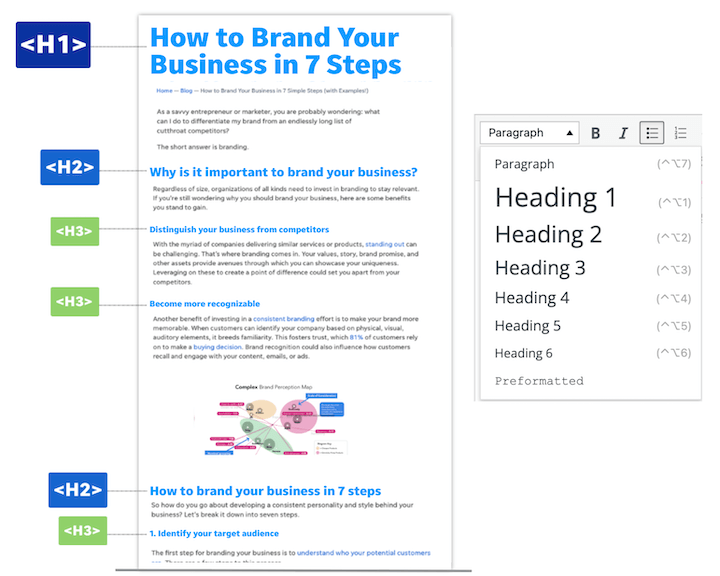
Strategically Position Your Keywords
To effectively signal to Google the focus of your content, it’s essential to incorporate your keyword in specific locations on your webpage. Here’s where you should ensure your keyword appears:
- SEO Title (Title Tag)
- Main Page Title (H1 Tag)
- In a Minimum of Two Subheadings (H2 Tags)
- Image Alt Text
- Image File Name
- Naturally Within the Content
- Webpage URL
- Meta Description
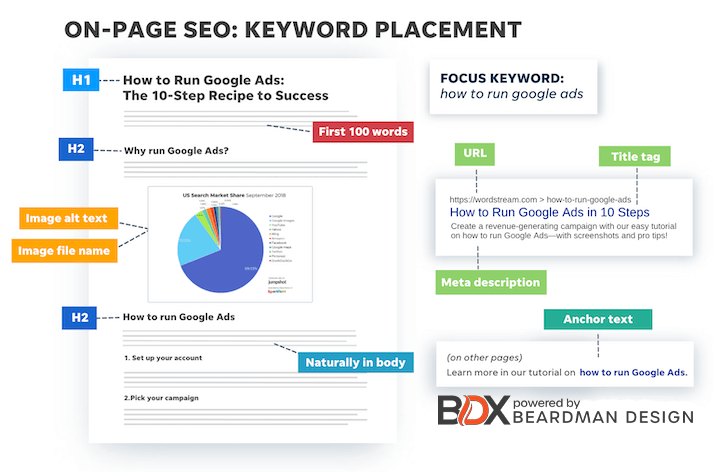
Refine Your Headings
Every webpage typically features two distinct titles. The title tag, visible on the Search Engine Results Page (SERP), is crucial for SEO and should be treated with importance. On the other hand, the H1 tag is the headline users see upon landing on the page. Their similarity often varies based on the content.
For effective title optimization, consider the following:
- Incorporate the Keyword: Seamlessly integrate your keyword and, if possible, include related terms to enhance relevance.
- Stick to One H1 per Page: This should represent the primary topic, while H2s can demarcate major subsections.
- Limit Title Tags to 55-60 Characters: Google’s display is pixel-based rather than character count, so it’s wise to place the keyword towards the beginning.
- Highlight the Benefit: Clearly convey the value or takeaway of the page. This can influence click-through rates from the SERP and engagement on your site.
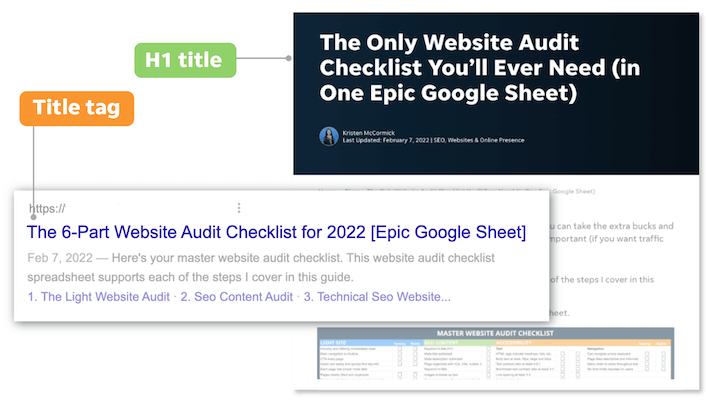
Optimize Your Meta Descriptions
The meta description is a brief summary that appears beneath the title tag on the SERP. While Google might sometimes generate its own description based on the search query, it’s essential to craft a compelling meta description for SEO purposes, as it aids Google in comprehending the page’s content.
For an effective meta description:
- Seamlessly Integrate the Keyword: Along with the primary keyword, try to naturally incorporate related terms to enhance relevance.
- Maintain Brevity: Aim for a meta description length of about 155-165 characters.
- Craft a Captivating Summary: Your goal is not just to appear on the SERP but to entice users to click. Offer a succinct overview, highlight the main benefit, and incorporate a call to action, akin to a catchy advertisement.
For instance, here’s a sample of a meta description as seen in search results:
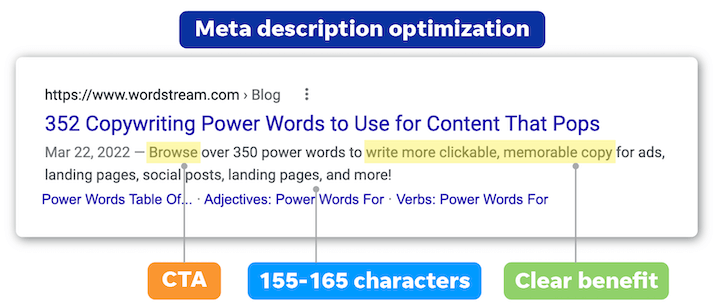
Incorporate and Optimize Images
Images play a pivotal role in enhancing SEO. They not only captivate the audience but also elevate the content’s richness. Moreover, with Google’s emphasis on a more visual SERP, images can be a gateway to drive traffic to your pages, especially through image search results.
Here’s a guide to optimizing images for SEO:
- File Naming: Use the keyword when naming the file, separating words with dashes.
- Alt Text Integration: Alt text, or alternative text, is the textual representation of an image. It aids Google in understanding the image’s context in relation to the keyword. Beyond SEO, alt text is crucial for screen readers, ensuring accessibility. If an image fails to load, the alt text serves as a placeholder. When crafting alt text, avoid overloading it with keywords. Instead, describe the image as if explaining it to someone visually impaired.
- Image Compression: Bulky images can hinder your site’s loading speed. Compress images to minimize file size without compromising quality. Typically, images shouldn’t exceed 1000px in width, but this can vary based on the website’s design.
Internal and external links
For effective SEO, especially in blog articles, it’s essential to weave in both internal and external hyperlinks.
External links: Integrate 1-3 links that direct readers to authoritative websites related to your content topic. By linking to reputable sites, you enhance your content’s credibility in the eyes of Google.
Internal links: Seamlessly embed links that guide readers to other relevant articles or pages within your website. For instance, as I did earlier with the term “authoritative websites,” using it as my anchor text. This interlinking strategy not only enriches the user experience but also provides Google with a structured roadmap of your site, facilitating efficient crawling. The number of links you should incorporate largely depends on your article’s length and the volume of related content on your site. Ensure that the hyperlinks align with the context of your content and the chosen anchor text.
👆Pro tip: It’s natural to add links to old blog posts in your new blog posts, but you should also go back into old blog posts and add in links to new posts.
How to Implement SEO: Off-Page Techniques
While we’ve delved into on-page SEO tactics, it’s equally crucial to understand off-page SEO. This refers to actions taken outside of your own website, on other web pages or platforms, to boost your page’s ranking. Here’s a breakdown of some prominent off-page SEO methods:
Acquire and Solicit Quality Backlinks
Links pointing to your website from external sources, known as backlinks, rank as one of the top influencers in Google’s ranking algorithm. Naturally, links from reputable and authoritative websites carry more weight than those from lesser-known sites. The greater the number of premium backlinks you secure, the better your chances of achieving a higher ranking.
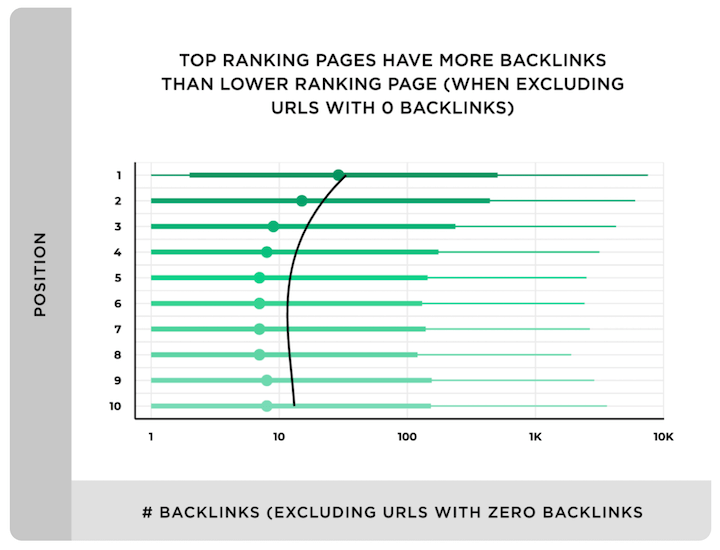
How can you increase your backlink count? There are multiple approaches, but some of the most effective ones are:
- Crafting unique and genuine content that naturally attracts backlinks.
- Actively approaching websites where your content could add value and requesting a link.
- Contributing guest articles to other sites.
- Gaining media or press coverage.
Promote your content through social channels
Beyond just linking your main website on your social media profiles, it’s essential to consistently share your articles and updates with your followers. This not only drives direct traffic but also increases the likelihood of others linking back to your content. While social media isn’t a direct ranking factor for Google, the interactions and engagement on these platforms can send positive signals to search engines, indirectly impacting your site’s position.
Enhance your brand’s credibility
Google’s ranking decisions aren’t solely based on individual pages. It also considers the overall reputation of your brand by evaluating various online indicators such as reviews, ratings, recognitions, awards, and even instances where your brand is mentioned without a link. Therefore, bolstering your brand’s credibility through optimized listings, securing positive media coverage, and soliciting reviews is crucial for SEO. While many of these tactics align with local SEO, there are numerous strategies to elevate the reputation of businesses that aren’t necessarily tied to a physical location.
Technical SEO: Backend Enhancements
Technical SEO involves backend adjustments to your website, ensuring it aligns with Google’s security standards and offers an optimal user experience. It also facilitates Google’s ability to efficiently crawl and index your site. Here are some primary technical enhancements to consider:
- Loading Time: Beyond just image dimensions, the underlying code and its loading sequence can influence the speed of your page. Techniques like lazy loading and other speed optimization practices are crucial.
- Site Security: Transition your site to HTTPS from HTTP to ensure data safety.
- Mobile Optimization: Simply being mobile-friendly isn’t enough. With Google’s shift to mobile-first indexing, your website must be fully adaptable to mobile devices.
- Core Web Vitals: These metrics gauge the user’s interaction quality with your webpage. Discover ways to enhance your Core Web Vitals in dedicated resources.
- URL Organization: A systematic URL structure, such as categorizing under /blog, /landing-page, or /product, aids Google in crawling your site, enhances user navigation, and simplifies data segmentation in analytics.
- Website Layout: A user should ideally reach any page on your site within three clicks. Effective internal linking plays a pivotal role in achieving this.

- Canonical URLs: A canonical URL is the web address you designate to represent a group of duplicate pages. While Google attempts to discern the canonical URL from a set of duplicates, you can also guide Google using canonical tags or 301 redirects. For instance, consider:
- http://examplewebsite.com
- http://examplewebsite.com/
- https://examplewebsite.com
- https://examplewebsite.com/
- https://www.examplewebsite.com/
All these converge to this singular canonical URL:
- https://www.examplewebsite.com
- Crawl and Index Management: Your sitemap combined with your robots.txt file instructs Google on which pages to crawl and which ones to index or ignore.
- Structured Data: Structured data aids Google and other search engines in comprehending the nature of your content, enabling the display of enhanced results when suitable. For instance, sitelink structured data can expand your presence on the search results page, or SERP:
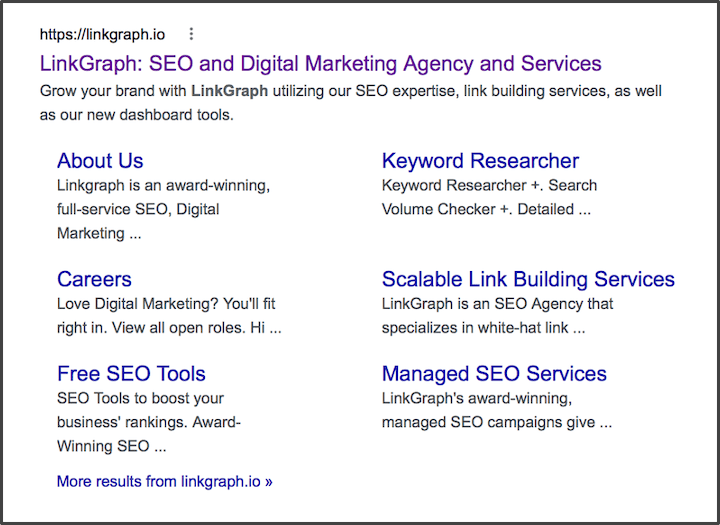
While review schema can give you more appeal:

There are lots of schema types that apply to different types of businesses.
SEO tools
To execute proficient search engine optimization, you require insights, and obtaining these insights necessitates the use of tools. Fortunately, many of these tools are available at no cost. Here are some top-tier SEO instruments to enhance your optimization approach:
- Google Analytics: This is the gold standard for website traffic analytics, and it’s free. Use it for any and all SEO metrics to measure your performance, such as traffic, time on page, engagement with page, number of pages per session, and (lots) more.
- Google Search Console: GSC is essential for content-focused and technical SEO. Although some Search Console data appears in Google Analytics, there is a lot you get in the platform on its own. Use it for Core Web Vitals, granular query analyses, indexing, and more.
- Keyword research tools: As mentioned above, you’ll need these so you can find keywords that are realistic for you to target in terms of search volume and competition.
- SEO software: If you’re going to look at deeper SEO metrics like backlinks, competitive information, and more advanced keyword data, you’ll need a paid SEO tool like Ahrefs, Moz Pro, Screaming Frog, SEMrush, etc. Some of these offer free trial versions or free services for the first 500 (or something) links.
- Website graders: Whereas the aforementioned tools are often complex and require you to know how to make sense of the data, website graders can simplify SEO for you and offer more guidance.
Head here to get an instant SEO audit with our Free Website Grader.
SEO strategies and best practices
Let’s finish off with some SEO strategies, best practices, and tips to help you get the most out of your time.
- Always always search the keyword: What you think users are looking for when they perform a particular search in Google may not be what they’re actually looking for. Keyword intent matters, so always search the keywords you’re trying to target to make sure you have an intent match.
- Be patient: SEO takes time. Like, a lot of time. It can take a few months before you really start to see the fruit of your efforts, but once you start seeing the impact, the benefits compound over time—so don’t give up prematurely!
- Focus on quality: Google is always updating its algorithm and coming out with new SERP features, but at the end of the day, it’s all designed to surface the best content out there. So your focus should always remain on creating useful, trustworthy content consistently. That is the best SEO strategy above all else.
- Maintain your content: While the consistent publication of quality content is the top Google ranking factor, this should not be at the expense of letting old content go stale. Regularly refresh your evergreen pages to preserve their SEO value and get consistent traffic growth over time.
- Track and measure: Report on your traffic and site data regularly so you can see what topics resonate most with your audience, detect issues, and set goals for traffic growth.
Continue to learn SEO
This guide should get you off to a firm start with SEO optimization, but we have a number of additional resources to help you learn SEO. Many of them have been linked in the guide, but here are some more:
And as we mentioned above, you can get a free, instant SEO audit with our free Website Grader.
